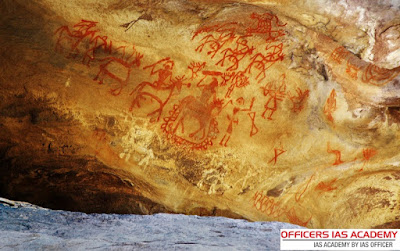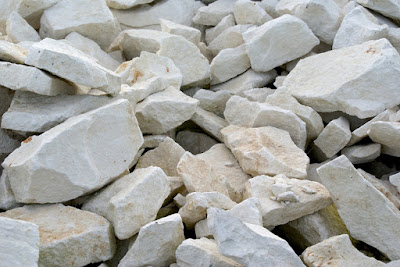Prehistoric period :
·
The distant past when there was no paper or language or the
written word, and hence no books or written document, is called as the
Prehistoric period.
·
Piecing together of information deduced from old tools, habitat,
bones of both animals and human beings and drawings on the cave walls scholars
have constructed fairly accurate knowledge about what happened and how people
lived in prehistoric times.
·
Paintings and drawings were the oldest art forms practised by
human beings to express themselves using the cave wall as their canvas.
Prehistoric Period:
1) Paleolithic
Age,
2) Mesolithic
Age and
3) Chalcolithic
Age
(1) Paleolithic Age Art
·
The prehistoric period in the early development of human beings
is commonly known as the ‘Old Stone Age’ or ‘Palaeolithic Age’.
·
Palaeolithic period can be divided into three phases:
(1) Lower Palaeolithic (2.5 million years-100,000 years ago)
(2) Middle Palaeolithic (300,000-30,000 years ago)
(3) Upper Palaeolithic (40,000-10,000 years ago)
(1) Lower Palaeolithic (2.5 million years-100,000 years ago)
(2) Middle Palaeolithic (300,000-30,000 years ago)
(3) Upper Palaeolithic (40,000-10,000 years ago)
·
We did not get any evidence of paintings from lower or middle
palaeolithic age yet.
·
In the Upper Palaeolithic period, we see a proliferation of artistic
activities.
·
Subjects of early works confined to simple human figures, human activities,
geometric designs and symbols.
·
First discovery of rock paintings in the world was made in India
(1867-68) by an Archaeologist,Archibold
Carlleyle, twelve years before the discovery of Altamira in Spain
(site of oldest rock paintings in the world).
·
In India, remnants of rock paintings have been found on the
walls of caves situated in several districts of Madhya Pradesh, Uttar Pradesh, Andhra
Pradesh, Telangana, Karnataka, Bihar and Uttarakhand.
·
Some of the examples of sites early rock paintings are Lakhudiyar in Uttarakhand, Kupgallu in Telangana, Piklihal and
Tekkalkotta in Karnataka, Bhimbetka and Jogimara in Madhya Pradesh etc.
·
Paintings found here can be divided into three categories: Man, Animal and Geometric symbols.
·
Some of the characteristics of these early paintings are:
1.
Human beings are represented in a stick-like form.
2.
A long-snouted animal, a fox, a multi-legged lizard are main
animal motifs in the early paintings (later many animals were drawn).
3.
Wavy lines, rectangular filled geometric designs and a group of
dots also can be seen.
4.
Superimposition of paintings – earliest is Black, then red and
later White.
·
In the late historic, early historic and Neolithic period the
subjects of paintings developed and figures like Bulls, Elephants, Sambhars,
Gazelles, Sheep, Horses, styled human beings, tridents and rarely vegetal
motifs began to see.
·
The richest paintings are reported from Vindhya range of Madhya
Pradesh and their Kaimurean extension into U.P.
·
These hills are fully Palaeolithic and Mesolithic remains.
·
There are two major sites of excellent prehistoric paintings in
India:
(1) Bhimbetka Caves, Foothills of Vindhya, Madhya Pradesh.
(2) Jogimara caves, Amarnath, Madhya Pradesh.
(1) Bhimbetka Caves, Foothills of Vindhya, Madhya Pradesh.
(2) Jogimara caves, Amarnath, Madhya Pradesh.
Bhimbetka Caves :
·
Continuous occupation of the caves from 100,000 B.C– 1000
A.D
·
Thus, it is considered as an evidence of long cultural
continuity.
·
It was discovered in 1957-58.
·
Consists of nearly 400 painted rock shelters in five clusters.
·
One of the oldest paintings in India and the world (Upper
palaeolithic).
The features of paintings of three different phases are as follows (even though Bhimbetka contains many paintings of periods later, different from what is explained explained below, as we are dealing with prehistoric period only, we are concluding by these three):
The features of paintings of three different phases are as follows (even though Bhimbetka contains many paintings of periods later, different from what is explained explained below, as we are dealing with prehistoric period only, we are concluding by these three):
Upper Palaeolithic
Period:
·
Paintings are linear representations, in green and dark red, of
huge animal figures, such as Bisons, Tigers, Elephants, Rhinos and Boars beside
stick-like human figures.
·
Mostly they are filled with geometric patterns.
·
Green paintings are of dances and red ones of hunters.
(2) Mesolithic period Art:
·
The largest number of paintings belongs to this period.
·
Themes multiply but the paintings are small in size.
·
Hunting scenes predominate .
·
Hunters in groups armed with barbed spears, pointed sticks,
arrows and bows.
·
Trap and snares used to catch animals can be seen in some
paintings.
·
Mesolithic people loved to point animals.
·
In some pictures, animals are chasing men and in others they are
being chased by hunter men.
·
Animals painted in naturalistic style and humans were depicted
in a stylistic manner.
·
Women are painted both in nude and clothed.
·
Young and old equally find places in paintings.
·
Community dances provide a common theme.
·
Sort of family life can be seen in some paintings (woman, man
and children).
(3) Chalcolithic period Art:
·
Copper age art.
·
The paintings of this period reveal the association, contact and
mutual exchange of requirements of the cave dwellers of this area with settled
agricultural communities of the Malwa Plateau.
·
Pottery and metal tools can be seen in paintings.
·
Similarities with rock paintings:
Common motifs (designs/patterns like cross hatched squares,
lattices etc)
·
Difference with rock paintings:
Vividness and vitality of older periods disappear from these paintings.
Some of the general features of
Prehistoric paintings (based on the study of Bhimbetka paintings) :
·
Used colours, including various shades of white, yellow,
orange, red ochre, purple, brown, green and black.
·
But white and red were their favourite.
·
The paints used by these people were made by grinding various
coloured rocks.
·
They got red from haematite (Geru in India).
·
Green prepared from a green coloured rock called Chalcedony.
·
White was probably from Limestone.
·
Some sticky substances such as animal fat or gum or resin from trees
may be used while mixing rock powder with water.
·
Brushes were made of plant fibre.
·
It is believed that these colours remained thousands of years
because of the chemical reaction of the oxide present on the surface of rocks.
·
Paintings were found both from occupied and unoccupied caves.
·
It means that these paintings were sometimes used also as some
sort of signals, warnings etc.
·
Many rock art sites of new painting are painted on top of an
older painting.
·
In Bhimbetka, we can see nearly 20 layers of paintings, one on
top of another.
·
It shows the gradual development of the human being from period
to period.
·
The symbolism is inspiration from nature along with slight
spirituality.
·
Expression of ideas through very few drawings (representation of
men by the stick like drawings).
·
Use of many geometrical patterns.
·
Scenes were mainly hunting and economic and social life of
people.
·
The figure of flora, fauna, human, mythical creatures, carts,
chariots etc can be seen.
·
More importance for red and white colours.














It was very help full for my new site…
ReplyDeleteAluminium Scaffolding Manufacturer In Delhi
Painting a graceful lady is always a pleasure for painters. A lady holds the power and elegance to rule the world. Are you looking forward to gracing your office and house with a beautiful lady painting? If yes, then IndianArtZone is the right choice for you to choose from a plethora of designs. The designs are also customizable according to your preference. Visit their website to learn more about their collections.
ReplyDeletehttps://www.indianartzone.com/woman-lady-paintings-canvas-paintings-artworks
Buy kohbar painting from this website.
ReplyDeleteVerry good! Thanks for made this pdf and try again other important topic
ReplyDeleteVerry interesting topic
ReplyDeleteGreat job, This content is very very great content, I got really good information from this content and it helps me a lot, I hope it can help many people like me.
ReplyDeleteUPSC Book Shop
UPSC Books
I feel really happy to have seen your webpage and look forward to so many more entertaining times reading here. Same as your blog I found another one Sohman Epoxy
ReplyDelete. Actually, I was looking for the same information on the internet forSohman Epoxy
and came across your blog. I am impressed by the information that you have on this blog. Thanks once more for designs.
This piece of writing is really a fastidious one
ReplyDeleteit assists new internet users, who are wishing for blogging.
bharatanatyam class near me
hobby classes online